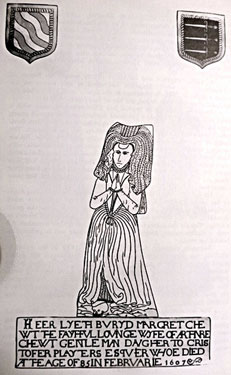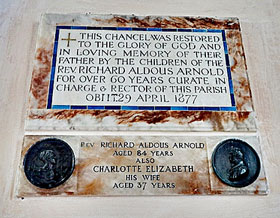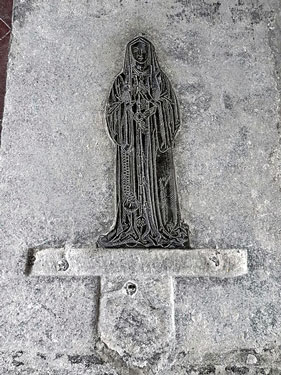|
|
|
|
|
| Aldburgh Assington Ampton Blythburgh Boxted Bramfield Brent Eleigh Brome Brundish Bures Bury St Edmunds Culford Dalham Dunwich Ellough Elmswell | |||
| Aldburgh - St Peter & St Paul |
 |
 |
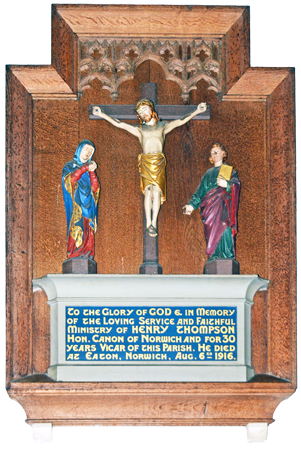 |
| Left:
George Crabbe (1832)
by Thurloe. Poet, surgeon and cleric Above left: Newson Garrett (1893) Maltster Above right:Henry Thompson (1916) Vicar for 30 years; Hon. Canon of Norwich |
||
| Assington - St Edmund | |
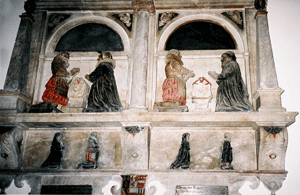 |
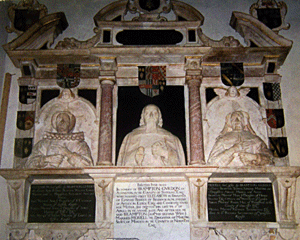 |
| Robert (1577) & Wife and John Gurdon (1623) & Wife | Brampton Gurdon (1648) & Two Wives |
| Ampton - St Peter |
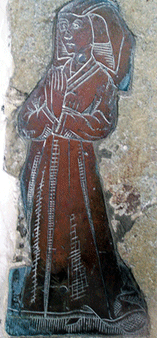 |
||
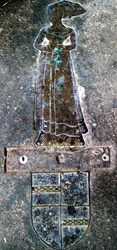 |
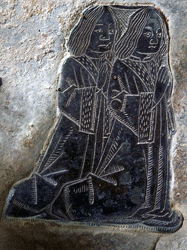 |
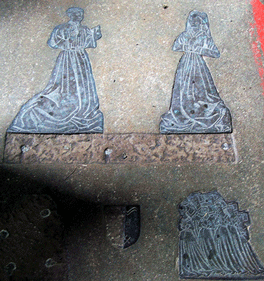 |
|
| Brass of
c.1490 pamlimsest of portion of lady of c. 1460 |
Two sons c. 1490 | Brass of c. 1480; probably of the Cockets | Brass of c.1480 |
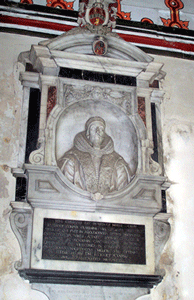 |
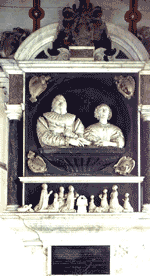 |
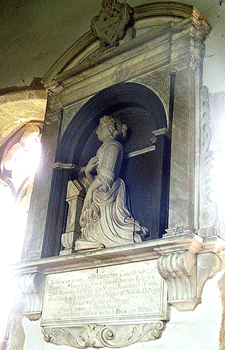 |
 |
| William Whettell (1628) by Nicholas Stone. | Sir Henry Calthorpe (1638) & Wife by John & Matthias Christmas |
Dorothy Calthorpe (1693 at 45)
'To the pious memory of Mrs Dorothy Calthorpe, this virgin foundress of the alms house, left this life for a better...' 'A virgin rotary is oft in snares this safely vow'd and made ye poor her heirs' |
James Calthorpe (1784) Attrib. to Bacon. MP for Hindon 1699-1784; he was unmarried and the last of the line. |
|
|
| Boxted - Holy Tritity |
|
|
|
|
||
|
Above:
William Poley (1587) & Wife The effigies are of oak, a
late use of this material. |
| Bramfield - St Andrew |
|
 |
|
|
Above & left: Arthur Coke (1629) & Wife by Nicholas Stone. She holds her dead baby. |
 |
Brome - St Mary |
 |
| Brome is difficult to find. From the A140,
turn east signed posted Brome; then at the first crossroads do
not carry straight on - which looks the obvious way - but rather
turn left on a 'yellow' road which has no signpost, at
least when we visited. Brome is a
straggly village and the church is soon on the right. Church is open and you can park in the road outside although there is little space. Very dark interior. O/S Ref: TM 146 764 |
 |
 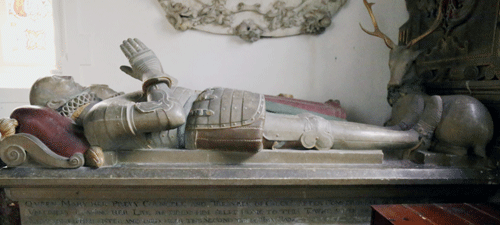 |
 |
|
Sir Thomas Cornwallis (1604) & Anne (Jerningham). Eldest son of Sir John (below). They were supporters of Mary II (Tudor); he was Comptroller of the Royal Household as well as Treasurer of Calais. Later he was accused of selling Calais to the French and imprisoned for many years, although this charge was probably political in origin. |
||
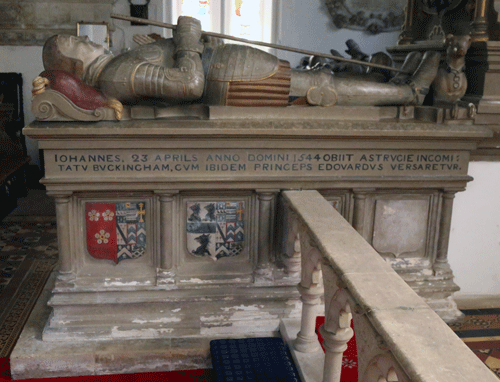 |
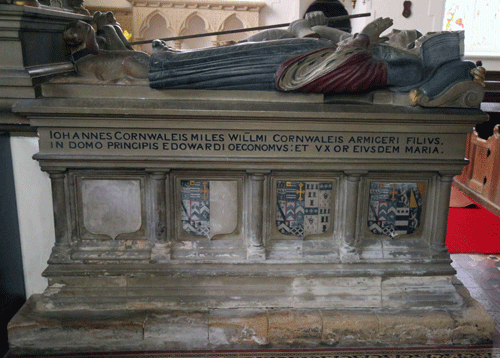 |
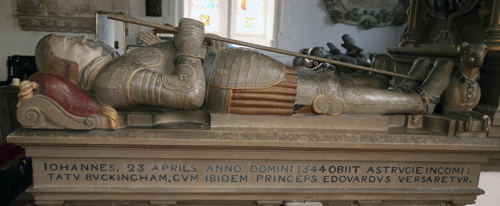 |
 |
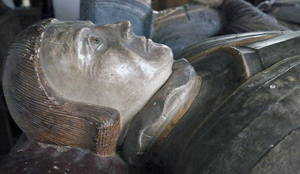 |
 |
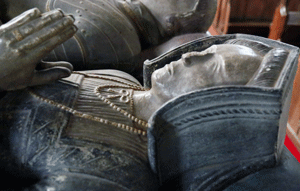 |
| Sir John Cornwallis (1544) . and Mary (Suilliard) Steward to the household of Prince Edward (later Edward VI) |
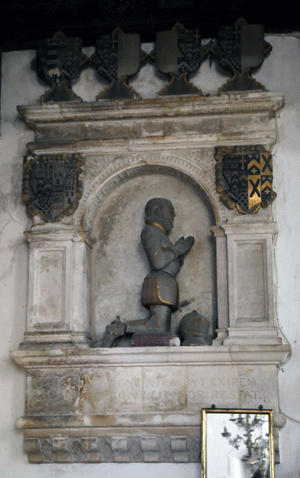 |
 |
| Frederick, 1st Baron Cornwallis (1662) He was granted the honour from Charles II upon their return from exile, but clearly did not live long to enjoy it. | Lady Elizabeth Cornwallis (1681 ) Married Charles, 3rd Baron Cornwallis, at 18, had four sons and died at 25. |
|
Brundish St Lawrence |
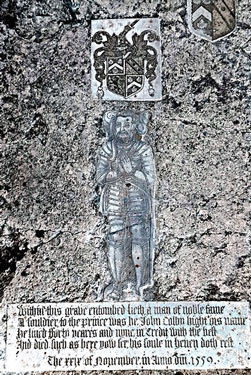
'Under this grave entombed lieth a man of noble fame, a
souldier to the prince was he. John Colby
night his name. He lived forty years and nyne, in credit
with the best and died such as here yow see, his soul in
heven doth rest The 29 of November in AD 1599'
|
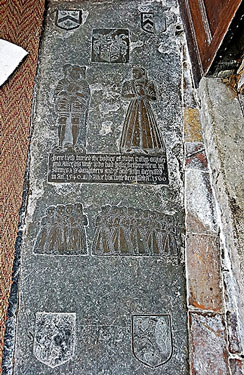
'Here lieth buried the bodies of John Colby
esquire and Alice his wife who had issue
between them 4 sonnes & nine daughters and ye said John
deceased in Ano 1540 and Alice his wife
deceased Ano 1560'
|

Edmund de Burnedisshe (1360)
Parson of Castrre (Castor) The insciption is in Norman
French
|
 |
 |
 |
|
| Francis Colby (1599) and Margery (Wentworth) (1528). His brass is now in possession of Philadelphia Museum of Art | 'If life in God and like of good, yf love of Christ, and eke his word. Yf strif with vice, as fire with wood, if death with faith; in th'only Lord are tokens sure of endless bliss, which God prepared, has for his. Then Thomas Glenham here doth lye who rests with Christ in heaven hye.' | ||
| Bures |
Bures is a village which is bisected by the River Stour and so straddles the Essex/Suffolk border. It consists of two civil parishes: Bures Hamlet, which is in Essex, and Bures St Mary, which is in Suffolk. The village is mainly referred to as simply Bures and here is St Mary's Church and about a mile away is St Stephen's Chapel. In the 17th century the village was known as Bewers and the standard pronunciation is still now something like brewers without the first r, although Nicola, the parish administrator, told me there are several pronunciations locally. |
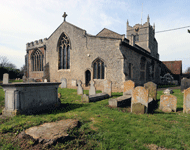 |
Bures - St Mary |
 |
| The church is open during daylight hours. There is some free parking outside the church. Very good toilets. This is the most friendly and welcoming church we have visited. O/S Ref: TL 907 340 |
 |
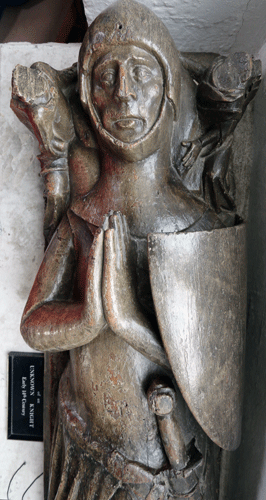 |
 |
 |
Left: Knight, cross legged early 14th C. Oak (now under north window) Above: details of spur |
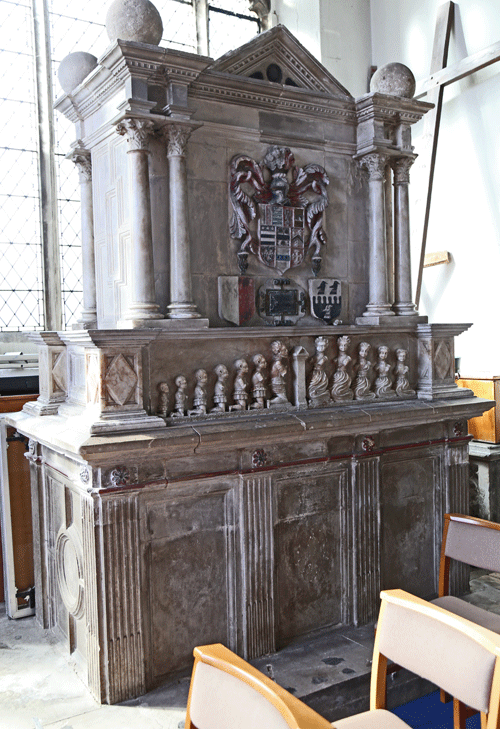 |
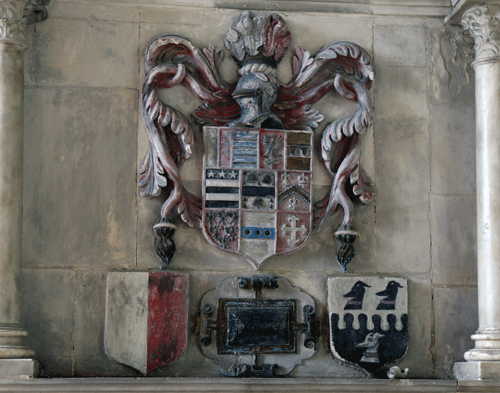 |
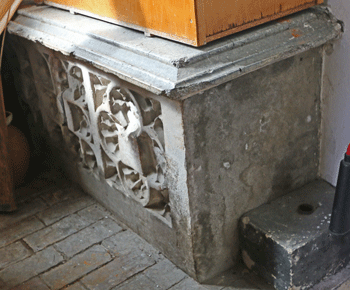 Far left: Sir William Waldergrave (1613) & his first wife Elizabeth (Mildmay) (1581) He served as MP for Suffolk and sheriff of Suffolk and Norfolk At the immediate left are details of the heraldry and the kneeling children, seven boys and five girls. Above: A small tomb chest with no indication to whom it belongs. This is slotted into a narrow space between the Waldergrave monument and the wall, the space being used as a store. I removed most of this material but the box I was reluctant to move! |
 |
 Above: Sir Richard Waldegrave (1410) & Joan (de Bures) (1406) in the chancel. He was the first Speaker of the House of Commons. On the lid are the indents of brass, shown right bottom. However the visible panel of tomb chest looks later, 16th century, and may have been a replacement. The iron grill separating the chancel and vestry may have been added at this time. The two angel corbels would have supported a canopy over the tomb. Right top: Sir George Waldegrave (1528) Brass indents for figures and shields can be seen on the sloping lid and shields on the front face. |
.png)  |
|
 |
Bures - St Stephen's Chapel |
 |
| The chapel is about one mile north east from the village. Find Cuckoo Hill and climb it until you reach Fysh Farm. St Stephen's Chapel is soon signposted along a track on your right. Take this track to a signposted car park on you left, behind a barn. On your right there is a large reclamation centre. Continue along the track and, although you can see a white dragon carved on the hillside in the distance, you will still not be able to see the chapel. Then follow the track to your right and you will see the chapel and a few houses in front of you. The chapel is now normally open but if it is not there is a list of key holders on the door: this includes St Mary's Church so it may be advisable to contact the church office (see web site) if you are planning a visit. O/S Ref: TL 918 344 |
 |
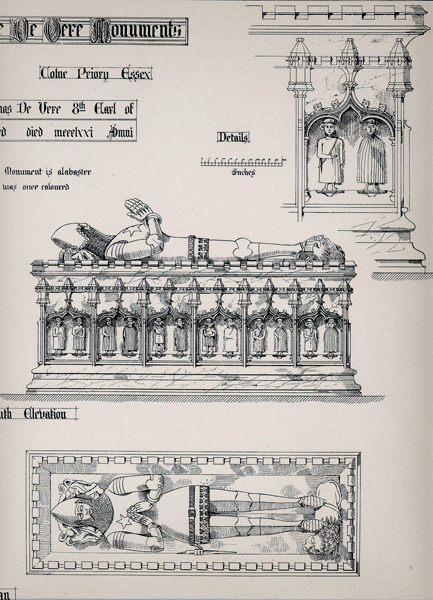 |
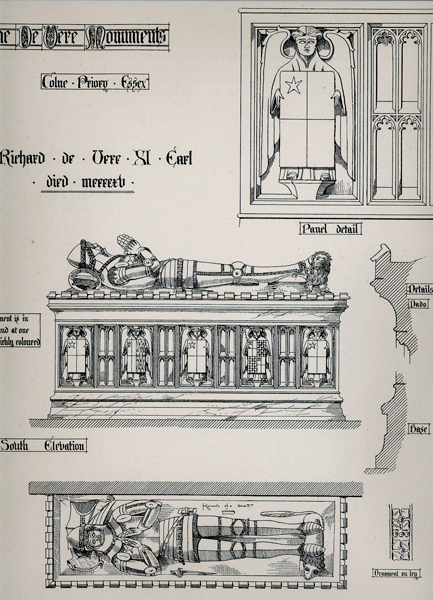 |
 |
|
These monuments were originally in Earl's Colne Priory, Essex,
the church where the De Vere Earls of Oxford were buried. The lithographs are taken from
Chancellor's Essex. Top Left: Robert de Vere, 5th Earl of Oxford (attribution in Chancellor) c 1300 The tomb chest does not belong. Top Right: Thomas de Vere, 8th Earl of Oxford (attribution in Chancellor) c1370 Alabaster. Note the deVere arms of a star on the 'jupon'. The tomb chest is said to have been wider originally and held 2 effigies. Lower Left: Richard de Vere, 9th Earl of Oxford (attribution in Chancellor) c 1420 Alabaster Lower Right: Alice de Vere, wife of the 9th Earl (attribution in Chancellor) c 1420 Alabaster see also below |
 |
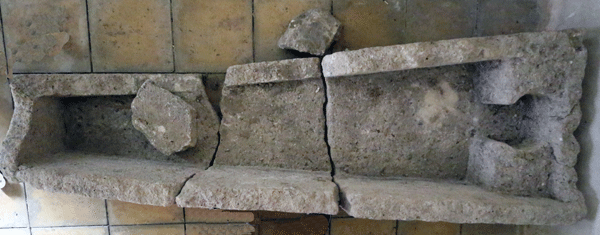 |
| Coffin lid mid 12th C lower half showing flatly carved legs. Said to be Alberic de Vere | Stone coffin |
| Alberic - or Aubrey - de Vere (born before 1080) was Joint Sheriff of London and Lord Great Chamberlain under King Henry I from 1133. He built Hedingham Castle, the seat of the Earls of Oxford, and was the father of Aubrey III, the first Earl of Oxford of that name. |
| Portraits | |||
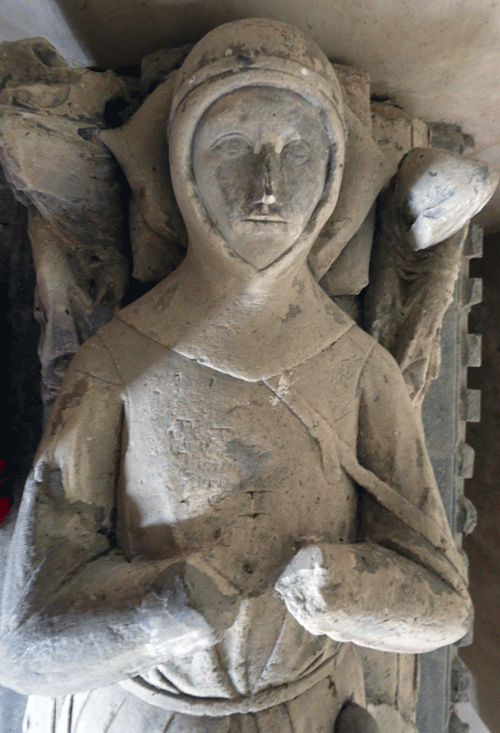 |
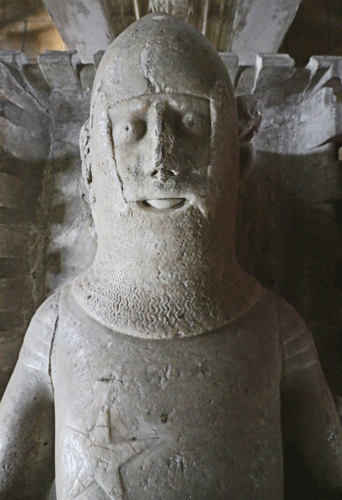 |
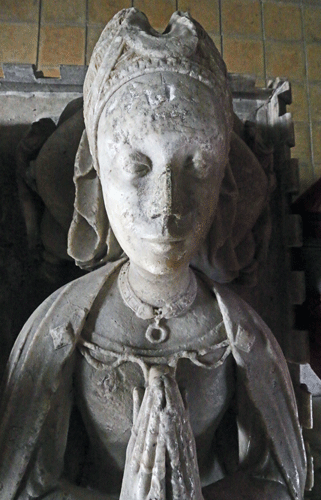 |
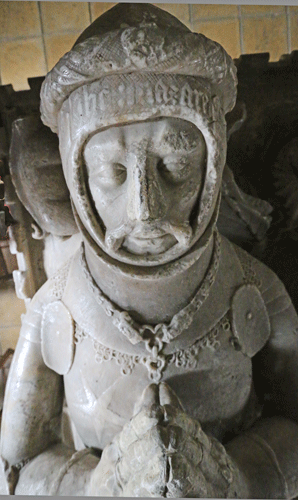 |
| Robert de Vere, 5th Earl (before 1296) | Thomas de Vere, 8th Earl of Oxford | Alice de Vere, wife of the 11th Earl | Richard de Vere, 11th Earl of Oxford |
|
Robert de Vere,
5th Earl of Oxford (before 1296) The tomb chest is from another monument |
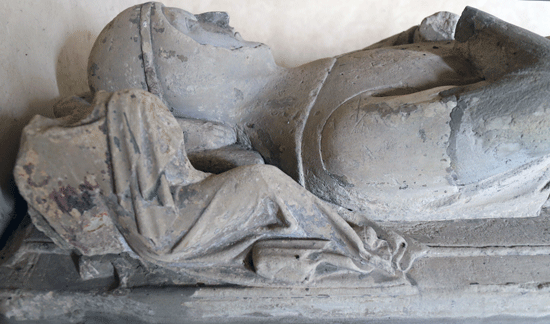 |
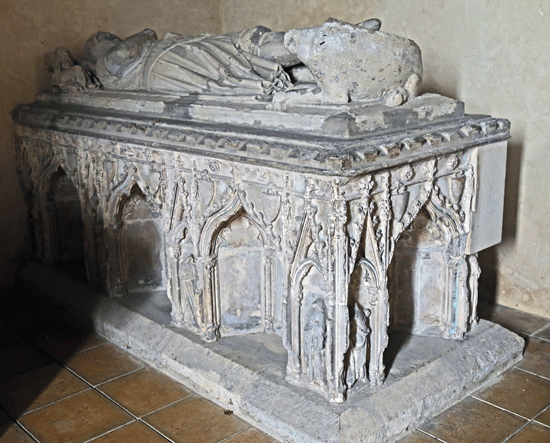 |
 |
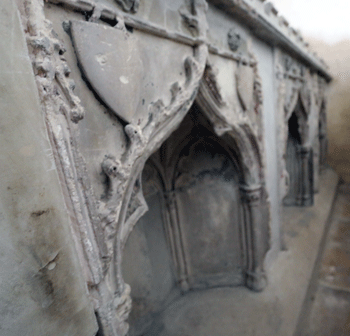 |
This effigy is probably that of Robert de Vere, 5th Earl of Oxford (d. before 1296) The effigy has been dated to around 1300 but the tomb chest is later , around 1340. We have no way of knowing what happened to the original tomb chest or even if there was one, and what effigy was on the present tomb chest or, again, if there ever was one. The etching in Gough is clearly of this monument when it was in the church and there are statues in each of the niches, a pair against the angled side wall of each. The majority had been lost by the time of Chancellor's drawings. Left shows the now empty left long side of the tomb chest which appears in Gough; the opposite, right, side appears in Chancellor as it does in the photographs. The latter shows that these niches are now empty. The tomb was clearly quite free standing when it was in the church. The 5th Earl was a follower of Simon de Montford in the Second Baron's Revolt of 1265. His lands were forfeited after the Battle of Evesham but were later restored |
| Thomas de Vere, 8th Earl of Oxford |
 |
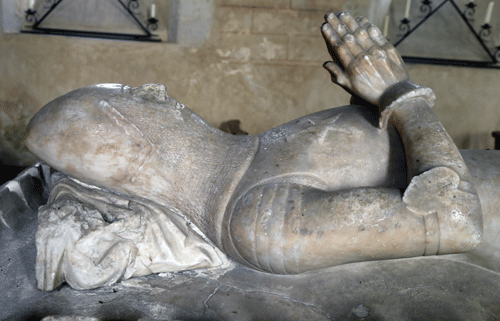  |
 |
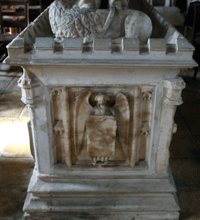 |
Thomas de Vere, 8th Earl of Oxford (1371) The photograph is more or less identical with the lithograph in Chancellor but both are different from the etching in Gough, where the effigy is shown lying on what is said to be a triple tomb chest but with no other effigies. In Gough two helms are shown either side of the head of the effigy, one with a boar as a crest and the other a bearded head. It is difficult to ascertain if the effigy lay in the centre of the tomb chest or on the right hand side, as the perspective in Gough is often curious. The tomb chest has obvious been cut to size at some point: the right hand long side is very similar to that in Gough but while there the pattern continues around the foot of the tomb, now there is now an alabaster panel with an angel holding a panel, taken from elsewhere. Thomas took part in the French wars of King Edward III. He married Maud de Afford, when the latter was still a child; his wife outlived him. She took part in a conspiracy in 1404 to depose King Henry IV and replace him by the deposed Richard II, who was by then dead anyway. She was buried with her late husband although no monument remains. Thomas married only once so it is not possible to say who the third occupant of the tomb might have been, although it may well have been only a double tomb and the poor perspective may have been misinterpreted. See below for more thoughts on this. |
| Richard de Vere, 11th Earl of Oxford & his wife Alice de Vere |
 |
 |
 |
| At the centre is the view from the gallery and to the left and right the end panels. That to the foot (right) has had a block inserted and an empty niche (and see below); that to the head two blocks inserted and what looks like a modern panel. | ||
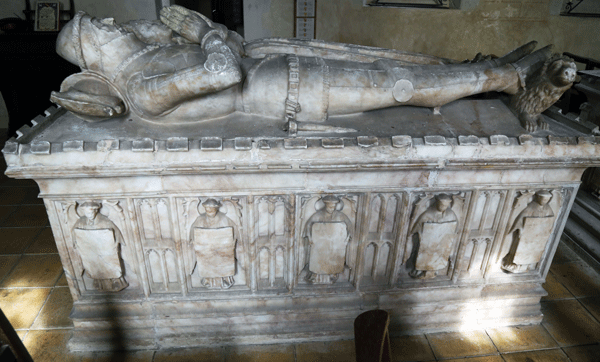 |
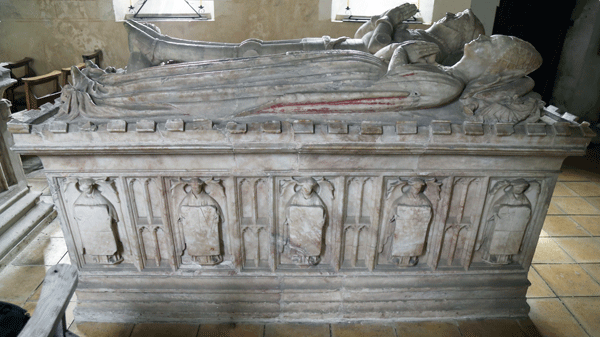 |
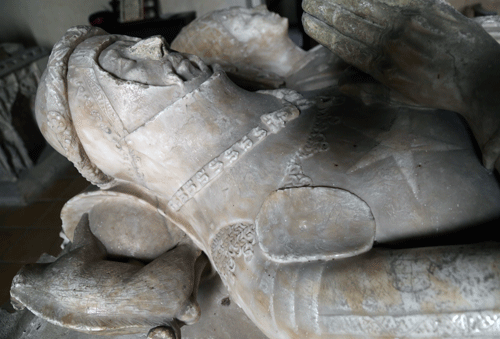 |
 |
 |
 |
| Richard de Vere, 11th Earl of Oxford & his wife Alice de Vere (Sergeaux) |
| Richard de Vere, 11th Earl of Oxford (1517) & Alice (Sergeaux) The etching in Gough shows this monument as it was when in the parish church. There are minor differences in the effigies, especially in the details of the armour, but, because of the frequent inaccuracies of the artists in Gough's work, these are of no significance. The whole tomb appears more or less as it does today. When this monument was moved from the church to the house (see below) the effigies were separated and the tomb chest cut in half: this is shown in the drawings in Chancellor. If you try to slot these two drawings together they do not fit, the lady having been turned around so both effigies would face the same way. The head and foot panels on the tomb chest are quite different now from those shown in the Gough etchings. The present foot panel looks like it may have come from the tomb chest which now belongs to the 5th Earl, although we cannot see if it has lost its head panel asthis aspect of the tomb chest is hard against the wall. There is another point here: the 8th Earl's monument has nine bays along the long sides and five bays along the head and foot panels: a ratio of about 2:1. On the 5th Earl's tomb chest there are six bays on the long sides and three bays on the head and foot sides, again a ration of 2:1. The 8th Earl monument is a double tomb whereas that of the 5th Earl is said to have been originally a triple monument. With these ratios in mind and the fact already mentioned that the 5th Earl married once, it seems highly likely that the 5th Earl's monument was a double tomb and the reports that it was a triple tomb is due to misinterpreting the poor perspective of the Gough etching. Alabaster with some remaining original polychrome on the lady's mantle. Richard de Vere took part in the trial of Richard, Earl of Cambridge and Lord Scrope for their part in the Southampton Plot against Henry V, the trial being presided over by Thomas, Earl of Clarence, the King's brother. He took part in the Siege of Harfleur during Henry V's invasion of France and was one of the commanders at the Battle of Agincourt in 1415 in the contingent of Humphrey, Duke of Gloucester, another of the King's brothers. He married twice: his first wife was Alice, daughter of John Holland, Duke of Exeter and Elizabeth, sister of Henry IV and next Alice Sergeaux, whom we see represented on the monument. There were no children by the first although there were by the second . He died in 1417 aged thirty one. |
| Something
about St Stephen's Chapel
& the Monuments History, Legend & Speculation |
It is said that St Stephen's Chapel was built on the site of a royal palace where, on Christmas Day 855, Bishop Humbert of Elmham anointed Edmund as king of the Anglo-Saxon kingdom of East Anglia. This consecration is said to have taken place at Burva, thought to refer to Bures. Edmund was the last of the kings for, in 869, the Great Danish Army , led by Ivan the Boneless and Ubba, descended on East Anglia and King Edmund wasprobably killed in battle. However, according to tradition the King was shot to death by a series of arrows and then beheaded for refusing to renounce his Christian faith. He was buried locally but eventually canonized and his body translated by King Cnut (the second of England's short dynasty of Danish kings) in 903 to the town now known as Bury St Edmunds in his honour. Saint Stephen's Chapel was built in the second decade of the 13th century by Gilbert de Tawny as a private chapel, replacing an earlier 9th century wooden building, and consecrated by the Archbishop of Canterbury, Stephen Langton, who was more famous for his struggle with King John, on St Stephen's Day 1218. The Chapel was abandoned at the Reformation. There are records that it was converted into a 'plague' (small pox) hospital in 1739, and later a school, farm workers' cottages and a barn; hence the occasional name of Chapel Barn. 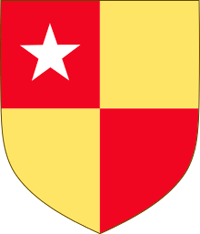 The de
Veres, Earls of Oxford, had chosen
Earls Colne
Priory as their place of burial and at the Reformation there
were said to be twenty-two tombs in this church. The priory was
abandoned during the Dissolution of the Monasteries in 1570 and
the buildings left to decay. However before these events three
of the monuments had been moved into the parish church of Earls Colne.
The 17th Earl sold off much of his inheritance - including the
Priory - to his stewards, the Harlackendens, in 1583 and 1592. The de
Veres, Earls of Oxford, had chosen
Earls Colne
Priory as their place of burial and at the Reformation there
were said to be twenty-two tombs in this church. The priory was
abandoned during the Dissolution of the Monasteries in 1570 and
the buildings left to decay. However before these events three
of the monuments had been moved into the parish church of Earls Colne.
The 17th Earl sold off much of his inheritance - including the
Priory - to his stewards, the Harlackendens, in 1583 and 1592.In 1629 the antiquarian Robert Cotton and Richard Harlakenden planned to move and preserve the ten surviving effigies and slabs still remaining on the site of the Priory Church; this plan, unfortunately, came to nothing and they were broken up for building material by Harlackenden's descendent, John Wales, for his house now known as Earls Colne Priory. Richard Gough's five volume work Sepulchral Monuments was published between 1786 and 1796 and contains etchings of the monuments when they were still situated in the parish church of Earls Colne. It must be noted that these etchings lack accuracy at times. Observations from Gough's work have been referred to above. In 1825 Wales's descendent at Earls Colne, Rev Henry Carardine, was rebuilding the manor house (at some point called Earls Colne Priory) and erected a gallery in the house to house the tombs from the church as the then Vicar of Earls Colne, in true Victorian fashion, was 'improving' the church, and is said to have threatened to eject the tombs. This explains which some notes state that the tombs were moved from the church to the 'new priory' using the annoying habit of referred to a house as a 'priory'. Photographs of these monuments appear in Essex: North East (Royal Commission on Historical Monuments), which was published in 1922, and show the tombs being set into a wall in what is described as a covered galley. These photographs show that the effigies on the double tomb had been separated at some point. The lithographs, shown above, from Chancellor's Essex, which was published in 1890, were also clearly drawn in the house; the effigies from the double tomb do not slot together in these lithographs and the fact that they had been separated explains why. There they stayed until in 1935 when Colonel William Carardine Probert, a descendent of the Rev Henry and who lived at Bures, inherited the property at Earls Colne. Earlier in 1918 St Stephen's Chapel and the surrounding lands and buildings had been bought by Isobel Badcock ⁻¹, artist, and she, with the help of her brother-in-law Colonel William, alluded to above, began the restoration of the Chaple and nearby buildings. Colonel William decided to sell the Earls Colne property and moved the monuments to the Chapel. Later in the 1920's the Alberic slab was found in a rock garden at Earls Colne and later still the stone coffin was found in a wood there; these too were brought to St Stephen's Chapel ⁻¹ Isobel Badcok never married but her sister Mary married Colonel Probert; as a child Mary had been the model John Tenniel used for his illustrations of the Alice books |
| Bury St Edmunds |
| Park in the modestly priced car park near the churches. Entrance to the Cathedral, to St Mary's and to the Abbey grounds is free; photography is allowed and thereare no charges. The churches and the abbey ruins are adjacent |
 |
Cathedral Cathedral Church of St James |
 |
| The cathedral is a cathedral of the Modern Foundation, the see being founded in 1914. Prior to this it was a medieval parish church, although the choir was rebuilt in 1867. The cathedral was further enlarge 1960-1970 The original church was built by the monks, it is said, so that the townsfolk did not worship in the abbey nave, because of hostility between them and the monks. |
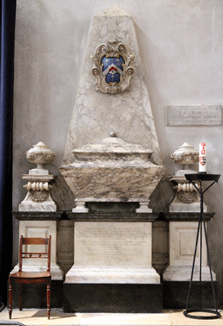 |
 |
| Mrs Reynolds (1736) | James Reynolds (1738) Chief Justice of the Exchequer. Black and white marble |
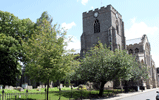 |
St Mary's Church |
 |
 |
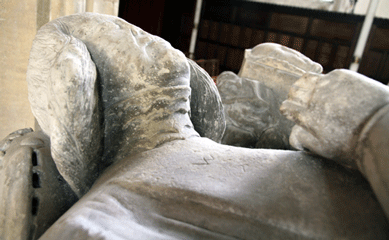 |
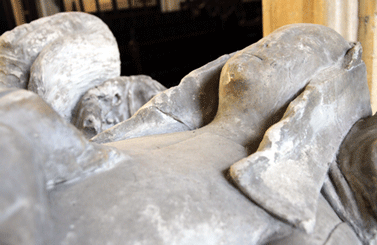 |
| Sir William Carew (1501) & Wife | ||
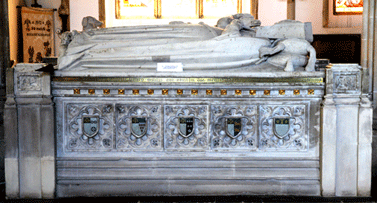 |
 |
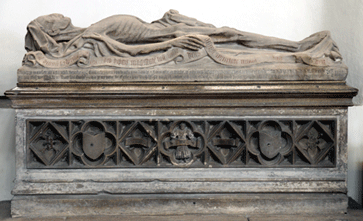 |
 |
| Sir Robert Drury (1536) & Wife. He was Speaker of the House of Commons. Canopy lost. | John Barat (1467) Cadaver effigy which hold the inscription shown below | ||
| 'He that will sadly behold one with his ie, May se hys owyn merowr and lerne for to die.' There are other inscriptions on the tomb chest, e.g: 'Thus erthe on to erthe to gedir now is knet, So endeth each creature Q'd John Baeret, Qwerfor ze pepil in weye of charite.' On the side of the tomb chest can be seen the figure of John Barat in life wearing his SS collar and holding a scroll with the words, 'Grace me Governe'. John Baret was a wealthy clothier and founded a chantry chapel to contain his tomb, the roof is painted in a repeated pattern with this latter inscription and the deceased's monogram surrounded by the SS collar . | |||
| A French Queen | Brasses | |

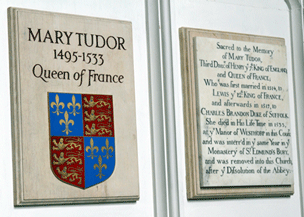 Mary Tudor (1533) Sister of Henry VIII; She married first Louis XII of France (who was the widower of Ann of Brittany who herself was the widow of Louis's cousin Charles VIII) and then, on his death, Charles Brandon, Duke of Suffolk, at first in secret. She was the grandmother of Lady Jane Gray. She was first buried in the Abbey and at the dissolution her remains were moved here. The photographs show the grave and wall plaques. The original tomb top was placed over her new grave. |

Above:
Jankyn Smith (1481) & Ann.
Brass
He built the chancel aisle and was supposed to have given
the town the Guildhall
Right: Archdeacon John Fyners (1509) brass Archdeacon of Sudbury |
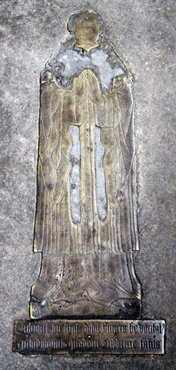 |
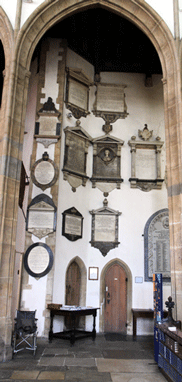  |
Wall Monuments |
 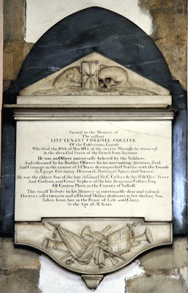 |
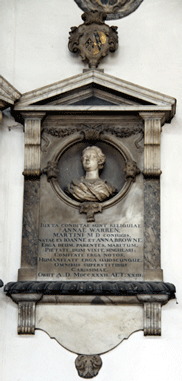
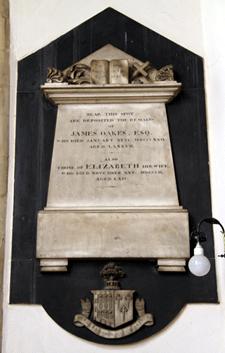  Above far left & right: General view of wall monuments, presumably resited at west end of north aisle. Above Left: Anna Martini (1732) Above Centre: James Oakes (1829) & Elizabeth (1802) Above Right: Joshua Grigby (1771) 'A Lawyer of unblemished integrety' Also his wife Mary Tubby (1767) Left: Edward William Lake (1922) Six times mayor Right: Lt Col Collier Coldstream Guards. Dow fighting the French 1814 aged 31 |
| The Abbey |
| The Abbey is in a ruinous state. There are several modern slabs covering the graves of early abbots in the chapter house (one is below shown left) and many18th and 19th century mostly now illegible wall monuments are fixed to the outside walls of the old charnal house; this building is railed off and locked. |

Ordingus (1148-1156)
Samson (1182-1210) shown Richard of the Island (1229-1233) Henry of Rushbroke (1233-1248) Edmund of Walpole (1248-1261) |

Weathered and illegible wall monuments
|
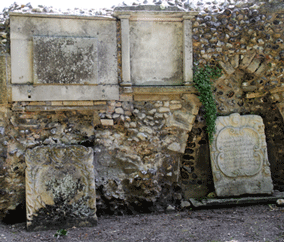 The tombstone to the right reads: 'Sarah...Worton..1698' |
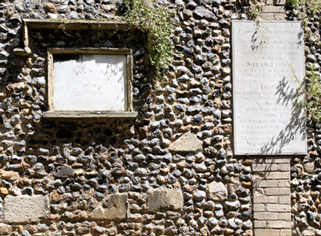
Left: 'Ann Spink'.
Right: 'Reader, pause at this humble stone <that>
records the fall of unguarded youth by the allurements of
vice and the treacherous snares of seduction. Sarah Lloyd on
the 23rd of April 1800 in the 22nd year of her age suffered
a just but ignominious death for admitting her abandon
<seducer> into the dwelling house of her mistress in the
night of 3rd October 1799 and becoming the instrument in his
hands of the crimes of robbery and house burning. These were
her last words: "May my example be a warning to Thousands."'
|

Illegible
|

Left:
The wall monument
to the far left reads: '_ Elizabeth _'; next, 'John Boldero'
and
that to the far right, 'William _'.
|
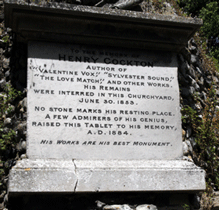
'Henry Cockton author of 'Valentine Vox',
'Sylvester Sound', 'The Love Match' and other works. His remains
were interred in this church yard June 30 1853. No stone marks
his resting place. A few admirers of his genius raised this
tablet to his memory AD 1884. His works are his best monuments'
|

Illegible
|
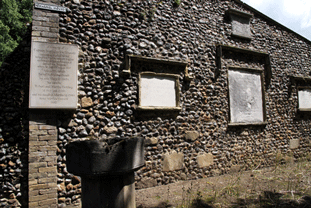
The tablet on the far left reads: 'Captain
Bartholomew Gosnold explorer and prime mover behind the first
permanent settlement in North American at Jamestown Virginia
where he died 22 August 1609. Also his familiy buried in this
churchyard. His wife Mary (d 1665) Her parents Robert and Martha
Golding (d 1611 and 1614) and his daughter Martha (d 1598) Hence
Martha's Vinyard 1602.'
The next tablet reads: 'Margaret ...Spink (1700)' |
 |
Culford - St Mary |
 |
| The church is open but
is another that is quite difficult to find as it in the large grounds of
Culford School. You may drive into the school and park outside
the sports hall; the church is then a 300 yards walk away. There is
no parking outside the church. There is also a public footpath
from Culford village. The old church was partially demolished in
1865 and rebuilt. O/S Ref: TL 883 703 |
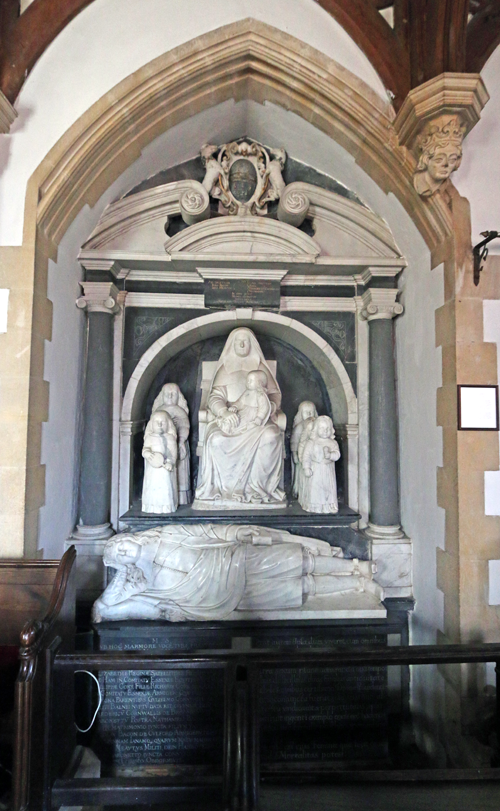 |
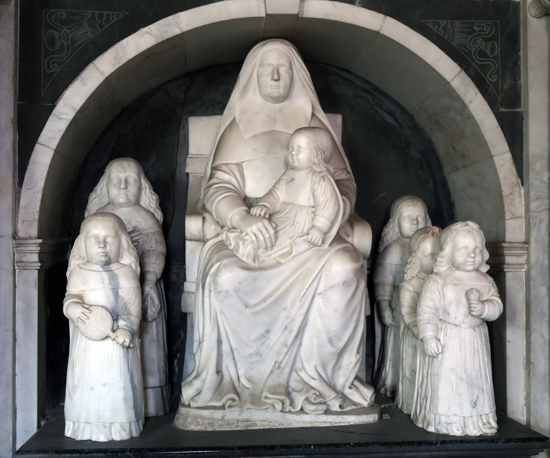 |
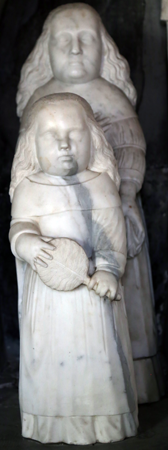
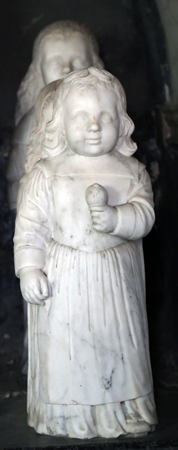
|
|
 |
Lady Jane is the central seated figure in this group; on her knee is her granddaughter, Anna, daughter of Lady Jane's daughter, Anne, who had married Sir Harbottle Grimstone. On lady Jane's right stands her daughter Jane, who died aged three; and Jane Meautys, another daughter of Anne but by her first marriage to Sr Thomas Meautys, and who had died aged ten., On Lady Jane's left side stand her great grandchildren, Ann, Frederick and Nathaniel Cornwallis, all of whom died in infancy; his figure is the most difficult to see. Sir Nicholas Bacon , Lady Jane's son by her second marriage reclines in the foreground. This figure was added in 1660: note the Royalist clothing. He died childless aged 43; in that year Frederick Cornwallis returned from exile and inherited the estates. Note that Jane wears the clothes of a Commonwealth lady while her son Nicholas wears Royalist clothing. The children all carry nosegays to ward off the plague. The memorial was commissioned during the Commonwealth from Thomas Stanton in 1654 for a cost of £300 by Lady Jane herself. She died in1659 and is buried below the monument |
| I have found that the sources about this monument conflicting in the identification of some of these figures; even the church guides cause confusion. One source says that the middle figure on Lady Jane's left is Frederick Cornwallis, Lady Jane's son by her first marriage, who in due course, inherited the estates, while her son by her second marriage, Nicholas Bacon, who reclines in the foreground , 'died in his youth' before he could inherit the estates. This is said to make the monument chronologically incorrect. Nicholas Bacon actually became mayor of Ipswich and died childless aged forty-four. That middle figure is also identified as another Frederick Cornwallis, who was the great grandson of Lady Jane, and who died in infancy; he is with his two sisters. I have also seen references to Lady Jane's husbands being represented here. The inscription on the base of the monuments refers to Lady Jane and her two marriages and the children from both; this has already been recorded above. I think I have resolved this confusion but if there is any further information about the identification then please let me know. |
 |
 |
|
 |
 |
|
Beatrix Jane Craven, Countess
Cadogan (1907) By Countess Feodora Gleichen |
 |
  |
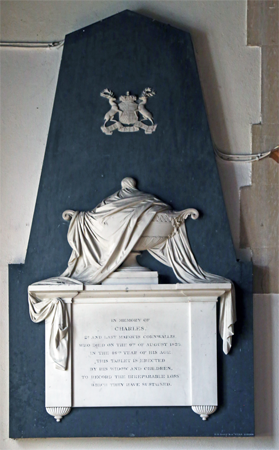 |
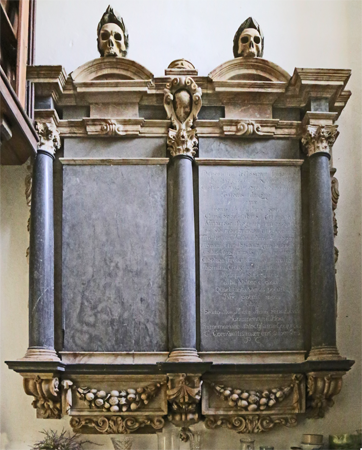 |
|
Sir Nathaniel Bacon (1627) He inherited the Coote estates and married Jane (see above) He was an artists and botanist: note the symbols on the monument. The monument was commissioned by his wife, Lady Janr |
Above:
Louisa Marchioness Cornwallis (1850) Bottom: Louisa Second daughter of Charles, 2nd Marquis Cornwallis (1872) |
Charles
2nd & last Marquis Cornwallis (1823) By E. H. Baily |
Sir Martin Stuteville (1631)
and his two wives Their children kneel in the 'predella' below |
|
|||||||
| Dunwich - St James |
| Church open during daylight hours |
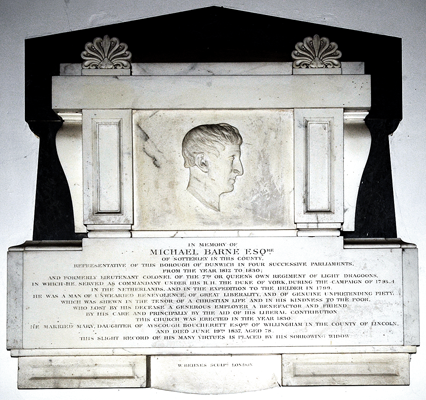 |
| Michael BarneMP Signed W Behnes Sculp London |


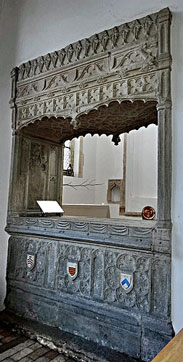
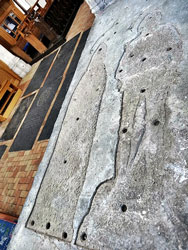
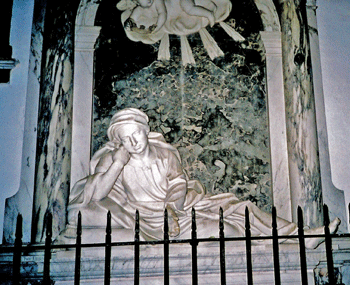


.png)
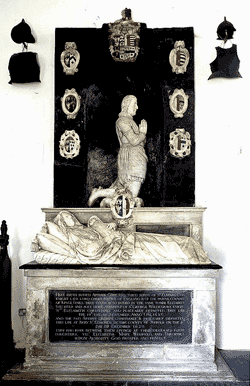
.png)
